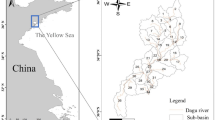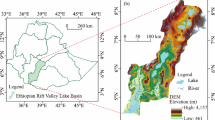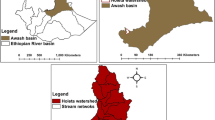Abstracts
Soil databases are one of the most important inputs for watershed models, and the quality of soil properties affects how well a model performs. The objectives of this study were to (1) quantify the sensitivity of model outputs to soil properties and to (2) use site-specific soil properties as a substitution for more accurate hydrological and nonpoint source (H/NPS) predictions. Soil samples were collected from a typical mountainous watershed in China, and the impacts of soil sample parameters on H/NPS predictions were quantified using the Soil and Water Assessment Tool (SWAT). The most sensitive parameters related to predicting flow, sediment, and total phosphorus (TP) mainly were the soil hydrological, the channel erosion processes, and the initial soil chemical environment, respectively. When the site-specific soil properties were used, the uncertainties (coefficient of variation) related to predicting the hydrology, sediment and TP decreased by 75∼80 %, 75∼84 %, and 46∼61 %, respectively. Based on changes in the Nash-Sutcliff coefficient, the model performance improved by 4.9 and 19.45 % for the hydrological and sediment model, accordingly. However, site-specific soil properties did not contribute to better TP predictions because of the high spatial variability of the soil P concentrations across the large watershed. Thus, although site-specific soil samples can be used to obtain more accurate H/NPS predictions, more sampling sites are required to apply this method in large watersheds.


Similar content being viewed by others
References
Abbaspour KC 2008: SWAT-CUP2: SWAT calibration and uncertainty programs—a user manual, Department of Systems Analysis, Integrated Assessment and Modelling (SIAM), Eawag, Swiss Federal Institute of Aquatic Science and Technology, CH
Abbaspour KC, Yang J, Maximov I, Siber R, Bogner K, Mieleitner J, Zobrist J, Srinivasan R (2007) Modelling hydrology and water quality in the pre-ailpine/alpine Thur watershed using SWAT. J Hydro 333:413–430
Anand S, Mankin KR, McVay KA, Janssen KA, Barnes PL, Pierzynski GM (2007) Calibration and validation of adapt and swat for field-scale runoff prediction. J Am Water Resour As 43:899–910
Arnold JG, Srinivasan R, Muttiah RS, Williams JR (1998) Large area hydrologic modeling and assessment—part 1: model development. J Am Water Resour As 34:73–89
Arnold JG, Moriasi DN, Gassman PW, Abbaspour KC, White MJ, Srinivasan R, Santhi C, Harmel RD, van Griensven A, Van Liew MW, Kannan N, Jha MK (2012) SWAT: model use, calibration, and validation. Trans ASABE 55:1491–1508
Beven K (2006) A manifesto for the equifinality thesis. J Hydro 320:18–36
Beven KJ, Smith PJ, Freer JE (2008) So just why would a modeller choose to be incoherent? J Hydro 354:15–32
Boomer KMB, Weller DE, Jordan TE, Linker L, Liu Z-J, Reilly J, Shenk G, Voinov AA (2013) Using multiple watershed models to predict water, nitrogen, and phosphorus discharges to the Patuxent Estuary. J Am Water Resour As 49:15–39
Bossa AY, Diekkrueger B, Igoe AM, Gaiser T (2012) Analyzing the effects of different soil databases on modeling of Hydro Process and sediment yield in Benin (West Africa). Geo 173:61–74
Burba GG, Verma SB (2005) Seasonal and interannual variability in evapotranspiration of native tallgrass prairie and cultivated wheat ecosystems. Agr Forest Meteorol 135:190–201
Camarero L, Garcia-Pausas J, Huguet C (2009) A method for upscaling soil parameters for use in a dynamic modelling assessment of water quality in the Pyrenees. Sci Total Environ 407:1701–1714
Chang C, Xie Z, Xiong G, ZHao C, Shen G, Lai J, Xu X (2009) Characteristics of soil nutrients of different vegetation types in the Three Gorges reservoir area (in Chinese). Acta Eco Sin 29:5978–5985
Chiang L-C, Chaubey I, Maringanti C, Huang T (2014) Comparing the selection and placement of best management practices in improving water quality using a multiobjective optimization and targeting method. Int J Environ Res Public Heal 11:2992–3014
Evanylo G, Sherony C, Spargo J, Starner D, Brosius M, Haering K (2008) Soil and water environmental effects of fertilizer-, manure-, and compost-based fertility practices in an organic vegetable cropping system. Agr Eco Environ 127:50–58
Fiorellino NM, McGrath JM, Momen B, Kariuki SK, Calkins MJ, Burk AO (2014) Use of best management practices and pasture and soil quality on Maryland horse farms. J Eq Veter Sci 34:257–264
Gatzke SE, Beaudette DE, Ficklin DL, Luo Y, O’Geen AT, Zhang M (2011) Aggregation strategies for SSURGO data: effects on SWAT soil inputs and hydrologic outputs. Soil Sci Socie Am J 75:1908–1921
Geza M, McCray JE (2008) Effects of soil data resolution on SWAT model stream flow and water quality predictions. J Environ Manage 88:393–406
Grey SN, Gupta HV (2015) The quantity and quality of information in hydrologic models. Water Resour Res 51:524–538
Guinot V, Cappelaere B, Delenne C, Ruelland D (2011) Towards improved criteria for hydrological model calibration: theoretical analysis of distance- and weak form-based functions. J Hydro 401:1–13
Huang H, Ouyang W, Guo B, Shi Y, Hao F (2014) Vertical and horizontal distribution of soil parameters in intensive agricultural zone and effect on diffuse nitrogen pollution. Soil Till Res 144:32–40
Kannan N, White SM, Worrall F, Whelan MJ (2007) Sensitivity analysis and identification of the best evapotranspiration and runoff options for hydrological modelling in SWAT-2000. J Hydrol 332:456–466
Li J, Pu L, Zhu M, Zhang J, Li P, Dai X, Xu Y, Liu L (2014) Evolution of soil properties following reclamation in coastal areas: a review. Geo 226:130–139
Lin HS, Wheeler D, Bell J, Wilding L (2005) Assessment of soil spatial variability at multiple scales. Eco Model 182:271–290
Lin Z, Radcliffe DE, Beck MB, Risse LM (2007) Modeling phosphorus in the upper Etowah River basin: identifying sources under uncertainty. Water Sci Techn 56:29–37
Lin C, Ma R, Zhu Q, Li J (2015) Using hyper-spectral indices to detect soil phosphorus concentration for various land use patterns. Environ Monit Assess 187:4130
Lu XX, Li S, He M, Zhou Y, Bei R, Li L, Ziegler AD (2011) Seasonal changes of nutrient fluxes in the Upper Changjiang basin: an example of the Longchuanjiang River, China. J Hydro 405:344–351
Luo X, Zheng Y, Lin Z, Wu B, Han F, Tian Y, Zhang W, Wang X (2015) Evaluating potential non-point source loading of PAHs from contaminated soils: a fugacity-based modeling approach. Environ Pollut 196:1–11
Ma X, Li Y, Zhang M, Zheng F, Du S (2011) Assessment and analysis of non-point source nitrogen and phosphorus loads in the Three Gorges Reservoir Area of Hubei Province, China. Sci Total Environ 412–413:154–161
Mapfumo E, Chanasyk DS, Willms WD (2004) Simulating daily soil water under foothills fescue grazing with the soil and water assessment tool model (Alberta, Canada). Hydro Process 18:2787–2800
Moltz HLN, Lopes VL, Rast W, Ventura SJ (2010) Hydrologic-economic analysis of best management practices for sediment control in the Santa Fe Watershed, New Mexico. J Hydro Engin 15:308–317
Naranjo RC, Niswonger RG, Stone M, Davis C, McKay A (2012) The use of multiobjective calibration and regional sensitivity analysis in simulating hyporheic exchange. Water Resour Res 48:W01538
Panagopoulos Y, Makropoulos C, Baltas E, Mimikou M (2011) SWAT parameterization for the identification of critical diffuse pollution source areas under data limitations. Eco Model 222:3500–3512
Park YS, Hyuk KJ (2014) Application and effectiveness analysis of SWAT Filter Strip in Golji Watershed. K Soc Environ Agr 33:30–36
Peschel JM, Haan PK, Lacey RE (2006) Influences of soil dataset resolution on hydrologic modeling. J Am Water Resour As 42:1371–1389
Pohlert T, Huisman JA, Breuer L, Frede HG (2007) Integration of a detailed biogeochemical model into SWAT for improved nitrogen predictions - Model development, sensitivity, and GLUE analysis. Eco model 203:215–228
Radcliffe DE, Reid DK, Blombaeck K, Bolster CH, Collick AS, Easton ZM, Francesconi W, Fuka DR, Johnsson H, King K, Larsbo M, Youssef MA, Mulkey AS, Nelson NO, Persson K, Ramirez-Avila JJ, Schmieder F, Smith DR (2015) Applicability of models to predict phosphorus losses in drained fields: a review. J Environ Qual 44:614–628
Ramos MC, Martinez-Casasnovas JA (2015) Soil water content, runoff and soil loss prediction in a small ungauged agricultural basin in the Mediterranean region using the Soil and Water Assessment Tool. J Agri Sci 153:481–496
Schwen A, Zimmermann M, Bodner G (2014) Vertical variations of soil hydraulic properties within two soil profiles and its relevance for soil water simulations. J Hydro 516:169–181
Shen ZY, Hong Q, Yu H, Niu JF (2010) Parameter uncertainty analysis of non-point source pollution from different land use types. Sci Total Environ 408:1971–1978
Shen Z, Chen L, Liao Q, Liu R, Hong Q (2012a) Impact of spatial rainfall variability on hydrology and nonpoint source pollution modeling. J Hydro 472: 205-215
Shen ZY, Chen L, Chen T (2012b) Analysis of parameter uncertainty in hydrological and sediment modeling using GLUE method: a case study of SWAT model applied to Three Gorges Reservoir Region, China. Hydrol Earth Sys Sci 16: 121-132
Shen ZY, Chen L, Liao Q, Liu RM, Huang Q (2013) A comprehensive study of the effect of GIS data on hydrology and non-point source pollution modeling. Agr Water Manage 118:93–102
Shen ZY, Zhong YC, Huang Q, Chen L (2015) Identifying non-point source priority management areas in watersheds with multiple functional zones. Water Res 68:563–571
USDA-SCS 1972: Hydrology Sect. 4, Soil Conservation Service National Engineering Handbook, Washington, DC
Wang X, Melesse AM (2006) Effects of STATSGO and SSURGO as inputs on SWAT Model’s Snowmelt Simulation. J Am Water Resour As 42:1217–1236
White KL, Chaubey I (2005) Sensitivity analysis, calibration, and validations for a multisite and multivariable SWAT model. J Am Water Resour As 41:1077–1089
Wischmeier WH, Smith DD (1978) Predicting rainfall erosion losses: a guide to conservation planning. U.S. Department of Agriculture, Washington, DC
Wu Y, Chen J (2012) Modeling of soil erosion and sediment transport in the East River Basin in southern China. Sci Total Environ 441:159–168
Xiao G, Hu T, Tang H, Yang J, Li Y, Zheng K, Wang Q (2011) Ecological distribution of soil microorganisms and identification of dominant bacteria in the area of the Three Gorges Reservoir before and after the fall (in Chinese). J Agr Sci 39:493–496
Xu D, Qin Y, ZHang L, Zheng B, Hai R (2009) Phosphorus Forms and Its Distribution Characteristics in Sediments and Soils of Water-Leve-l Fluctuating Zone of the Backwater Reach from Input River of Three Gorges Reservoir (in Chinese). Environ Sci 30:1337–1344
Xue C, Chen B, Wu H (2014) Parameter uncertainty analysis of surface flow and sediment yield in the Huolin Basin, China. J Hydro Engin 19:1224–1236
Yang J, Reichert P, Abbaspour KC, Yang H (2007) Hydrological modelling of the Chaohe Basin in China: statistical model formulation and Bayesian inference. J Hydro 340:167–182
Yang J, Reichert P, Abbaspour KC, Xia J, Yang H (2008) Comparing uncertainty analysis techniques for a SWAT application to the Chaohe Basin in China. J Hydro 358:1–23
Yang Y, Ye Z, Liu B, Zeng X, Fu S, Lu B (2014) Nitrogen enrichment in runoff sediments as affected by soil texture in Beijing mountain area. Environ Monit Assess 186:971–978
Ye X, Zhang Q, Viney NR (2011) The effect of soil data resolution on Hydro Process modelling in a large humid watershed. Hydro Process 25:130–140
Zhang B (2013) Study on distribution characteristics and flux of organic matter, nitrogen and phosphorus in the soil of WLFZ of Three Gorges Reservoir (in Chinese), Chongqing University, the municipality of Chongqing
Zhang X, Liang F, Srinivasan R, Van Liew M (2009) Estimating uncertainty of streamflow simulation using Bayesian neural networks. Water Resour Res 45:W02403
Zhang Y, Liu H-H, Houseworth J (2011) Modified Generalized Likelihood Uncertainty Estimation (GLUE) methodology for considering the subjectivity of likelihood measure selection. J Hydro Engin 16:558–561
Zhang X, Chen L, Li Q, Qi X, Yang S (2013) Increase in soil nutrients in intensively managed cash-crop agricultural ecosystems in the Guanting Reservoir catchment, Beijing, China. Geo 193:102–108
Zheng Y, Keller AA (2007) Uncertainty assessment in watershed-scale water quality modeling and management: 1. Framework and application of generalized likelihood uncertainty estimation (GLUE) approach. Water Resour Res 43:W08407
Acknowledgments
This research was funded by the CRSRI Open Research Program (no. CKWV2014221/KY), National Natural Science Foundation of China (nos. 51579011 and 51409003), and the Fund for Innovative Research Group of the National Natural Science Foundation of China (no. 51421065).
Author information
Authors and Affiliations
Corresponding author
Additional information
Responsible editor: Zhihong Xu
Rights and permissions
About this article
Cite this article
Chen, L., Wang, G., Zhong, Y. et al. Using site-specific soil samples as a substitution for improved hydrological and nonpoint source predictions. Environ Sci Pollut Res 23, 16037–16046 (2016). https://doi.org/10.1007/s11356-016-6789-8
Received:
Accepted:
Published:
Issue Date:
DOI: https://doi.org/10.1007/s11356-016-6789-8




